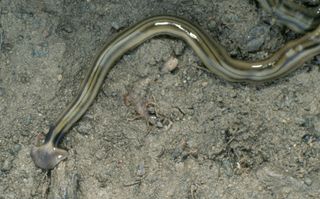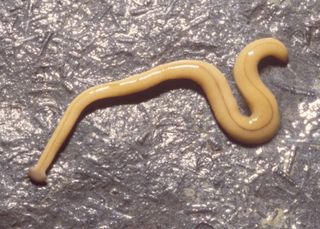Bizarre Hammerhead Worm with a 'Mustache' Captured on Video
A slithering "snake" with a bizarre mustache-shaped head posted on Facebook is actually a worm.
Facebook user Danish Ho of Johor Bahru, Malaysia, posted videos and images of the creature on the social media site on July 1, accompanied by the caption (in Chinese), "What is this snake???" The post has since been shared more than 127,000 times and has garnered more than 2,300 reactions and 3,500 comments.
To answer Ho's question: It's not a snake, despite its impressive size. It's a species of Bipaliinae, a subfamily of terrestrial flatworms, said Anna Phillips, an invertebrate zoologist at the Smithsonian Institution. [See Photos of Bristle Worms from Hell]
"The shape of the head isn't unusual for these worms," Phillips told Live Science. "They are also known as hammerhead worms."
Weird worms
Bipaliinae are found mostly in Madagascar, Southeast Asia and the Indian subcontinent (which includes countries such as Sri Lanka, Pakistan, Bhutan, Nepal, Bangladesh and the Maldives), Phillips said, though some species have established themselves in North America. They can grow more than a foot in length, often reproduce by dropping off part of their tail and regenerating, and eat earthworms, which makes them a threat to bait-farm operations, according to a 2009 article in U.S. News & World Report.
The worms' mouths are not located on their oddly shaped heads. Instead, they're right in the middle of their bodies, on their undersides, said Peter Ducey, a biologist at The State University of New York, Cortland, who researches these creatures. When the worms attack their prey, they first excrete glue-like mucus to adhere their soon-to-be dinner to their bodies. They then excrete digestive enzymes, reducing their prey to goo, which the flatworm can then suck up with its mouth (which also doubles as its anus). The non-squeamish can see pictures of this process at Ark In Space.
It's impossible to tell the species of the worm in the Facebook video from imagery alone, Ducey said — differentiating hammerhead worms requires dissection and DNA testing, because their coloration and body shape can differ between individuals of even the same species. But the worm is likely a species in the genus Bipalium, he said. Species in that genus have a wide variety of head shapes, Ducey told Live Science, ranging from blunt half-moons to the dramatic boomerang shape seen in the Malaysian specimen.
Sign up for the Live Science daily newsletter now
Get the world’s most fascinating discoveries delivered straight to your inbox.

The heads are dotted with chemoreceptors (a sense organ) and organs that scientists call eyes, though it's not really clear how much light those "eyes" can detect, Ducey said. No one knows for sure why the worms' heads are so weird-looking, but it could have to do with the positioning of these sensory organs, he said.
"If you have a big, broad head and you have chemical receptors on both sides of it, you can compare the right side and the left side," Ducey said. If one side detects more earthworm scent, he said, it could signal the worm to crawl in that direction.
Invasion of the hammerhead worms
Though hammerhead worms look quite exotic, four species have invaded the United States, Ducey said. None are quite as striking as the species that Ho captured on video.
"The ones here in the U.S. are not as photogenic as those really cool Asian creatures," Ducey said. Their colors are more muted and their heads less prominent. [See Photos of a Bizarre Flatworm & Other Destructive Invasive Species]
One such U.S. invader, Bipalium adventitium, is found from coast to coast across the northern United States. It probably originated in North Korea, northern Japan or China, Ducey said, because it's adapted to burrow deep underground during the winter freeze and to come up again in the spring.

Across the southern United States, also coast to coast, is Bipalium kewense; this worm can actually be found worldwide, Ducey said. Another species invading the U.S., Bipalium pennsylvanicum, is found only outside of Philadelphia. Finally, Bipalium vagum, a snail-eating variety of flatworm, lives along the Gulf Coast.
All four species probably became established in the United States at least a century ago, hitching rides in the pots of imported plants, Ducey said. B. vagum could prove to be an ecological threat to vulnerable mollusks, Ducey said. The other three invasive worms eat earthworms, and their environmental impact is unclear. B. adventitium eats invasive worm species, so its presence may not be entirely bad for the native ecosystem, Ducey said.
A 2014 study led by Amber Stokes, now at the University of California, Bakersfield, found that the worms produce a neurotoxin called tetrodotoxin, which they probably use for predation or defense. Whether that makes them dangerous to people is unclear, Ducey said.
"Let's say, 'Don't eat them,'" he said.
Original article on Live Science.

Stephanie Pappas is a contributing writer for Live Science, covering topics ranging from geoscience to archaeology to the human brain and behavior. She was previously a senior writer for Live Science but is now a freelancer based in Denver, Colorado, and regularly contributes to Scientific American and The Monitor, the monthly magazine of the American Psychological Association. Stephanie received a bachelor's degree in psychology from the University of South Carolina and a graduate certificate in science communication from the University of California, Santa Cruz.
Most Popular


